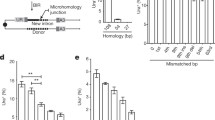Abstract
In this paper we study the influence of non-homology between plasmid and chromosomal DNA on the efficiency of recombinational repair of plasmid double-strand breaks and gaps in yeast. For this purpose we used different combinations of plasmids and yeast strains carrying various deletions within the yeast LYS2 gene. A 400 by deletion in plasmid DNA had no effect on recombinational plasmid repair. However, a 400 by deletion in chromosomal DNA dramatically reduced the efficiency of this repair mechanism, but recombinational repair of plasmids linearized by a double-strand break with cohesive ends still remained the dominant repair process. We have also studied the competition between recombination and ligation in the repair of linearized plasmids. Our experimental evidence suggests that recombinational repair is attempted but aborted if only one recombinogenic end with homology to chromosomal DNA is present in plasmid DNA. This situation results in a decreased probability of non-recombinational (i.e. ligation) repair of linearized plasmid DNA.
Similar content being viewed by others
References
Chernoff YO, Kidgotko OV, Demberelijn O, Luchnikova IL, Soldatov SP., Glaser VM, Gordenin DA (1984) Mitotic intragenic recombination in the yeast Saccharomyces cerevisiae: marker effect on conversion and reciprocity of recombination. Curr Genet 9:31–37
Conolly B, White CI, Haber JE (1988) Physical monitoring of mating type switching in Saccharomyces cerevisiae. Mol Cell Biol 8:2342–2349
Esposito M (1978) Evidence that spontaneous mitotic recombination occurs at the two strand stage. Proc Natl Acad Sci USA 75:4436–4440
Glaser VM, Glasunov AV, Tevzadze GG, Perera JR, Shestakov SV (1990) Genetic control of plasmid DNA double-strand gap repair in yeast Saccharomyces cerevisiae. Curr Genet 18:1–5
Glasunov AV, Glaser VM, Perera DR, Boreiko AV (1987) Model system for study of DNA double strand break repair in yeast Saccharomyces cerevisiae (in Russian). Mol Genet Microbiol Virusol 8:19–25
Golin J, Esposito MS (1981) Mitotic recombination: mismatch correction and replicational resolution of Holliday structures formed at the two strand stage in Saccharomyces. Mol Gen Genet 150:127–135
Gordenin DA, Trofimova MV, Shaburova ON, Pavlov YI, Chernoff YY, Chekuolene YV Proscyavichus YY, Sasnauskas KV, Janulaitis AA (1988) Precise excision of bacterial transposon Tn5 in yeast. Mol Gen Genet 213:398–393
Holliday R (1964) A mechanism for gene conversion in fungi. Genet Res 5:282–304
Inoue H, Nojima H, Okayama H (1990) High efficiency transformation of Escherichia coli with plasmid. Gene 96:23–28
Ito H, Fukuda Y, Murata K, Kimura A (1983) Transformation of intact yeast cells treated with alkali cations. J Bacteriol 153:163–168
Jha B, Ahne F, Eckardt-Schupp F (1993) The use of a double-marker shuttle vector to study DNA double-strand break repair in wild-type and radiation sensitive mutants of the yeast Saccharomyces cerevisiae. Curr Genet 23:402–407
McDonald JP, Rothstein R (1994) Unrepaired heteroduplex DNA in Saccharomycescerevisiae is decreased in RADIRAD52-in-dependent recombination. Genetics 137:393–405
Meselson M, Radding C (1975) A general model for genetic recombination. Proc Natl Acad Sci USA 72:359–361
Moore SW, Hampsey DM, Ernst JF, Sherman F (1988) Differential mismatch repair can explain the disproportionalities between physical distance and recombinational frequencies of cyc1 mutations in yeast. Genetics 119:21–34
Noskov VN, Tarutina HG, Pavlov YI (1990) Development of intragenic mapping system for molecular-genetic analysis of mutations in LYS2 gene of Saccharomyces cerevisiae (in Russian). Genetika 26:1161–1168
Orr-Weaver TL, Szostak JW (1983) Yeast recombination: the association between double-strand gap repair and crossing-over. Proc Natl Acad Sci USA 83:4417–4421
Orr-Weaver TL, Szostak JW, Rothstein RJ (1981) Yeast transformation: a model system for the study of recombination. Proc Natl Acad Sci USA 80:6354–6358
Orr-Weaver TL, Nicolas A, Szostak JW (1988) Gene conversion adjacent to regions of double-strand break repair. Mol Cell Biol 8:5292–5298
Perera JR, Glasunov AV, Glaser VM, Boreiko AV (1988) Repair of double-strand breaks in plasmid DNA in the yeast Saccharomyces cerevisiae. Mol Gen Genet 213:421–424
Resnick MA (1976) The repair of double-strand breaks in DNA: a model involving recombination. J Theor Biol 57:97–106
Robzyk K, Kassir Y (1992) A simple and highly efficient procedure for rescuing autonomous plasmid from yeast. Nucleic Acids Res 20:3790
Roman H, Fabre F (1983) Gene conversion and associated reciprocal recombination are separate events in vegetative cells of Saccharomyces cerevisiae. Proc Natl Acad Sci USA 80:6912–6916
Ronne H, Rothstein R (1988) Mitotic sectored colonies: evidence of heteroduplex DNA formation during direct repeat recombination. Proc Natl Acad Sci USA 85:2696–2700
Rothstein R (1984) Double-strand break repair, gene conversion and postdivision segregation. Cold Spring Harbor Symp Quant Biol 49:629–637
Sambrook J, Fritsch EF, Maniatis T (1989) Molecular cloning. A laboratory manual, 2nd edn. Cold Spring Harbor Laboratory Press, Cold Spring Harbor, New York
Strathern JN, Klar AJS, Hicks JB, Abraham JA, Ivy JM, Nasmyth KA, McGill C (1982) Homothallic switching of yeast mating type cassettes is initiated by a double-strand cut in the MAT locus. Cell 31:183–192
Suzuki K, Imai Y, Yamashita I, Fukui S (1983) In vivo ligation of linear DNA molecules to circular forms in the yeast Saccharomyces cerevisiae. J Bacteriol 155:747–754
Szostak JW, Orr-Weaver TL, Rothstein R, Stahl F (1983) The double-strand break repair model for recombination. Cell 33:25–35
White CI, Haber JE (1990) Intermediates of recombination during mating type switching in Saccharomyces cerevisiae. EMBO J 9:663–673
Wildenberg J (1970) The relation of mitotic recombination to DNA replication in yeast pedigrees. Genetics 66:291–304
Author information
Authors and Affiliations
Additional information
Communicated by C. P. Hollenberg
Rights and permissions
About this article
Cite this article
Glasunov, A., Frankenberg-Schwager, M. & Frankenberg, D. Influence of non-homology between recombining DNA sequences on double-strand break repair in Saccharomyces cerevisiae . Molec. Gen. Genet. 247, 55–60 (1995). https://doi.org/10.1007/BF00425821
Received:
Accepted:
Published:
Issue Date:
DOI: https://doi.org/10.1007/BF00425821




